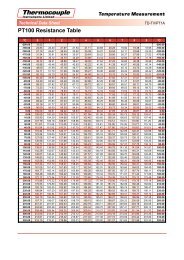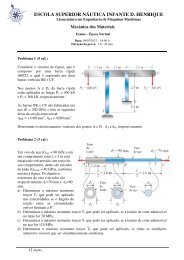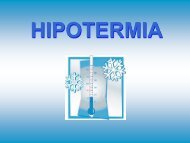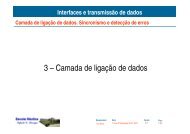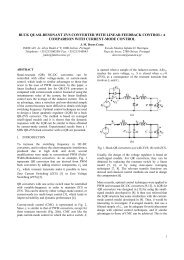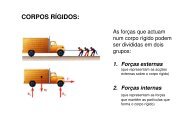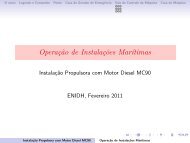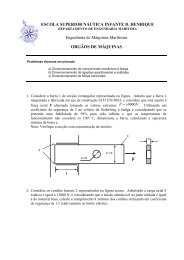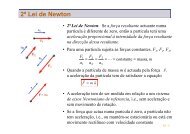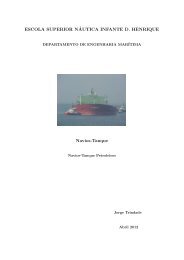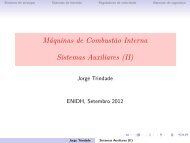Textos de Apoio (pdf)
Textos de Apoio (pdf)
Textos de Apoio (pdf)
Create successful ePaper yourself
Turn your PDF publications into a flip-book with our unique Google optimized e-Paper software.
ITTC – Recommen<strong>de</strong>d<br />
Procedures<br />
Performance, Propulsion<br />
1978 ITTC Performance Prediction<br />
Method<br />
7.5 – 02<br />
03 – 01.4<br />
Page 5 of 31<br />
Effective Date<br />
1999<br />
Revision<br />
00<br />
C<br />
DM<br />
and<br />
C<br />
DS<br />
⎡<br />
( ) ( )<br />
⎥ ⎥ ⎤<br />
⎞<br />
⎜<br />
⎛ t<br />
⎟⎢<br />
0.04 5<br />
= 2 1 + 2 −<br />
1<br />
2<br />
⎝ c ⎠⎢<br />
6<br />
3<br />
⎣ Rnco<br />
Rnco<br />
⎦<br />
⎛ t ⎞⎛<br />
⎞<br />
2 1 2 ⎜<br />
c<br />
⎜ + ⎟ 1.89 + 1.62.log ⎟<br />
⎝ c ⎠<br />
⎝<br />
k ⎠<br />
= p<br />
−2.5<br />
In the formulae listed above c is the chord<br />
length, t is the maximum thickness, P/D is the<br />
pitch ratio and R nco is the local Reynolds number<br />
at x=0.75. The bla<strong>de</strong> roughness k p is put<br />
k p =30.10 -6 m. R nco must not be lower than 2.10 5<br />
at the open-water test.<br />
2.4.3 Full Scale Wake and Operating Condition<br />
of Propeller<br />
The full scale wake is calculated from the<br />
mo<strong>de</strong>l wake, w TM , and the thrust <strong>de</strong>duction, t:<br />
w<br />
TS<br />
=<br />
( ) ( ) ( 1 + k ) C FS<br />
t + 0.04 + wTM<br />
− t − 0.04<br />
( 1 + k) C FM<br />
+ ∆C<br />
where 0.04 is to take account of rud<strong>de</strong>r effect.<br />
The load of the full scale propeller is obtained<br />
from<br />
K<br />
J<br />
=<br />
S<br />
.<br />
C<br />
T<br />
TS<br />
2 2D<br />
2<br />
1<br />
TS<br />
( 1 − t)( − w ) 2<br />
2<br />
With this K T<br />
/ J as input value the full<br />
scale advance coefficient J TS and the torque<br />
coefficient K QTS are read off from the full scale<br />
propeller characteristics and the following<br />
quantities are calculated<br />
- the rate of revolutions:<br />
F<br />
n<br />
S<br />
( − w )<br />
TS<br />
VS<br />
= 1 (r/s)<br />
J D<br />
TS<br />
- the <strong>de</strong>livered power:<br />
K<br />
5 3 QTS −3<br />
PDS<br />
= 2πρ D nS<br />
10 (kW)<br />
η<br />
- the thrust of the propeller:<br />
K<br />
T 2 4 2<br />
TS<br />
= . J . .<br />
2 TS<br />
ρ D nS<br />
(N)<br />
J<br />
- the torque of the propeller:<br />
KQTS<br />
5 2<br />
QS<br />
= ρD<br />
nS<br />
: (Nm)<br />
η<br />
R<br />
- the effective power:<br />
3 −3<br />
PE = CTS1/<br />
2ρ . VS<br />
. S.10<br />
(kW)<br />
- the total efficiency:<br />
PDS<br />
η<br />
D<br />
=<br />
P<br />
- the hull efficiency:<br />
1 − t<br />
η<br />
H<br />
= 1 − w<br />
E<br />
TS<br />
2.4.4 Mo<strong>de</strong>l-Ship Correlation Factors<br />
Trial prediction of rate of revolutions and <strong>de</strong>livered<br />
power with C P - C N corrections<br />
if CHOICE=0 the final trial predictions will be<br />
calculated from<br />
n T = C N .n S<br />
R<br />
(r/s)<br />
for the rate of revolutions and<br />
P DT = C P .P DS (kW)


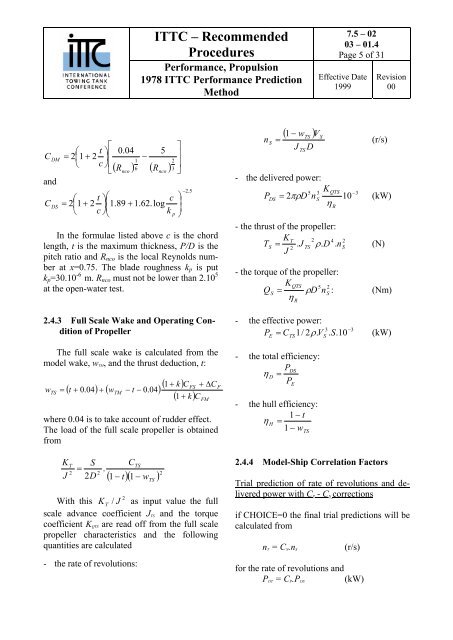
![Conceitos transmissao de dados .Sinais[.pdf]](https://img.yumpu.com/50982145/1/190x146/conceitos-transmissao-de-dados-sinaispdf.jpg?quality=85)
![Packages e interfaces[.pdf]](https://img.yumpu.com/50629553/1/190x134/packages-e-interfacespdf.jpg?quality=85)
